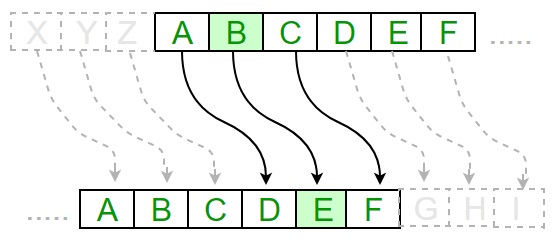
- Home
- Overview
- Double Strength Encryption
- Python Overview and Installation
- Reverse Cipher
- Caesar Cipher
- ROT13 Algorithm
- Transposition Cipher
- Encryption of Transposition Cipher
- Decryption of Transposition Cipher
- Encryption of files
- Decryption of files
- Base64 Encoding & Decoding
- XOR Process
- Multiplicative Cipher
- Affine Ciphers
- Hacking Monoalphabetic Cipher
- Simple Substitution Cipher
- Testing of Simple Substitution Cipher
- Decryption of Simple Substitution Cipher
- Python Modules of Cryptography
- Understanding Vignere Cipher
- Implementing Vignere Cipher
- One Time Pad Cipher
- Implementation of One Time Pad Cipher
- Symmetric & Asymmetric Cryptography
- Understanding RSA Algorithm
- Creating RSA Keys
- RSA Cipher Encryption
- RSA Cipher Decryption
- Hacking RSA Cipher
Cryptography with Python - Resources
Cryptography with Python - Caesar Cipher
In the last chapter, we have dealt with reverse cipher. This chapter talks about Caesar cipher in detail.
Algorithm of Caesar Cipher
The algorithm of Caesar cipher holds the following features −
Caesar Cipher Technique is the simple and easy method of encryption technique.
It is simple type of substitution cipher.
Each letter of plain text is replaced by a letter with some fixed number of positions down with alphabet.
The following diagram depicts the working of Caesar cipher algorithm implementation −

Example - Caesar Cipher Algorithm Usage
The program implementation of Caesar cipher algorithm is as follows −
main.py
def encrypt(text,s):
result = ""
# transverse the plain text
for i in range(len(text)):
char = text[i]
# Encrypt uppercase characters in plain text
if (char.isupper()):
result += chr((ord(char) + s-65) % 26 + 65)
# Encrypt lowercase characters in plain text
else:
result += chr((ord(char) + s - 97) % 26 + 97)
return result
#check the above function
text = "CEASER CIPHER DEMO"
s = 4
print ("Plain Text : ", text)
print ("Shift pattern : ", str(s))
print ("Cipher: ", encrypt(text,s))
Output
You can see the Caesar cipher, that is the output as shown in the following image −
Plain Text : CEASER CIPHER DEMO Shift pattern : 4 Cipher: GIEWIVrGMTLIVrHIQS
Explanation
The plain text character is traversed one at a time.
For each character in the given plain text, transform the given character as per the rule depending on the procedure of encryption and decryption of text.
After the steps is followed, a new string is generated which is referred as cipher text.
Hacking of Caesar Cipher Algorithm
The cipher text can be hacked with various possibilities. One of such possibility is Brute Force Technique, which involves trying every possible decryption key. This technique does not demand much effort and is relatively simple for a hacker.
The program implementation for hacking Caesar cipher algorithm is as follows −
main.py
message = 'GIEWIVrGMTLIVrHIQS' #encrypted message
LETTERS = 'ABCDEFGHIJKLMNOPQRSTUVWXYZ'
for key in range(len(LETTERS)):
translated = ''
for symbol in message:
if symbol in LETTERS:
num = LETTERS.find(symbol)
num = num - key
if num < 0:
num = num + len(LETTERS)
translated = translated + LETTERS[num]
else:
translated = translated + symbol
print('Hacking key #%s: %s' % (key, translated))
Output
Consider the cipher text encrypted in the previous example. Then, the output with possible hacking methods with the key and using brute force attack technique is as follows −
Hacking key #0: GIEWIVrGMTLIVrHIQS Hacking key #1: FHDVHUrFLSKHUrGHPR Hacking key #2: EGCUGTrEKRJGTrFGOQ Hacking key #3: DFBTFSrDJQIFSrEFNP Hacking key #4: CEASERrCIPHERrDEMO Hacking key #5: BDZRDQrBHOGDQrCDLN Hacking key #6: ACYQCPrAGNFCPrBCKM Hacking key #7: ZBXPBOrZFMEBOrABJL Hacking key #8: YAWOANrYELDANrZAIK Hacking key #9: XZVNZMrXDKCZMrYZHJ Hacking key #10: WYUMYLrWCJBYLrXYGI Hacking key #11: VXTLXKrVBIAXKrWXFH Hacking key #12: UWSKWJrUAHZWJrVWEG Hacking key #13: TVRJVIrTZGYVIrUVDF Hacking key #14: SUQIUHrSYFXUHrTUCE Hacking key #15: RTPHTGrRXEWTGrSTBD Hacking key #16: QSOGSFrQWDVSFrRSAC Hacking key #17: PRNFRErPVCURErQRZB Hacking key #18: OQMEQDrOUBTQDrPQYA Hacking key #19: NPLDPCrNTASPCrOPXZ Hacking key #20: MOKCOBrMSZROBrNOWY Hacking key #21: LNJBNArLRYQNArMNVX Hacking key #22: KMIAMZrKQXPMZrLMUW Hacking key #23: JLHZLYrJPWOLYrKLTV Hacking key #24: IKGYKXrIOVNKXrJKSU Hacking key #25: HJFXJWrHNUMJWrIJRT